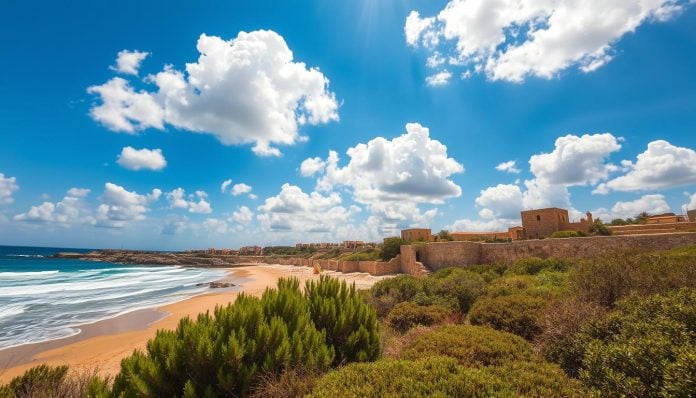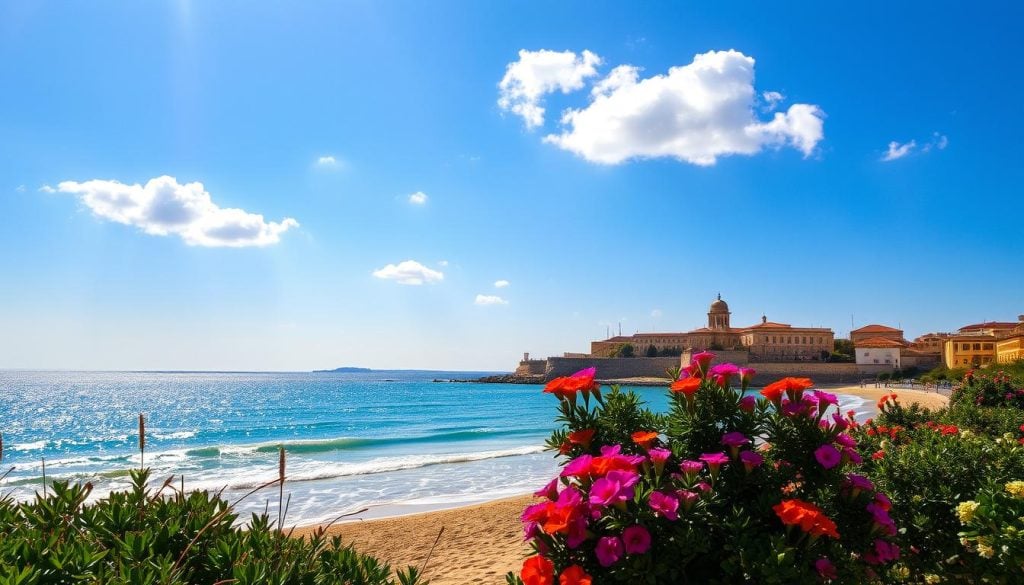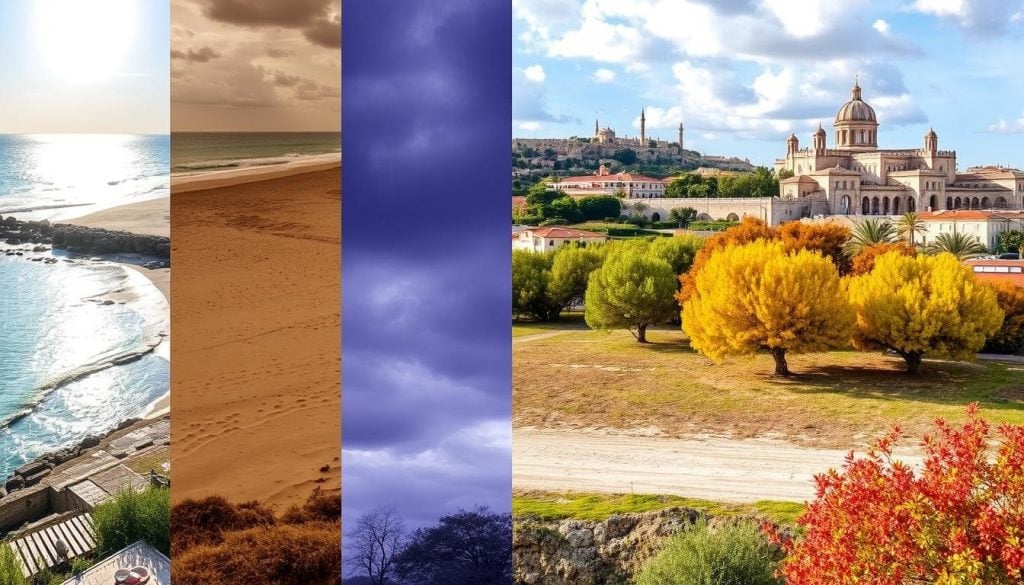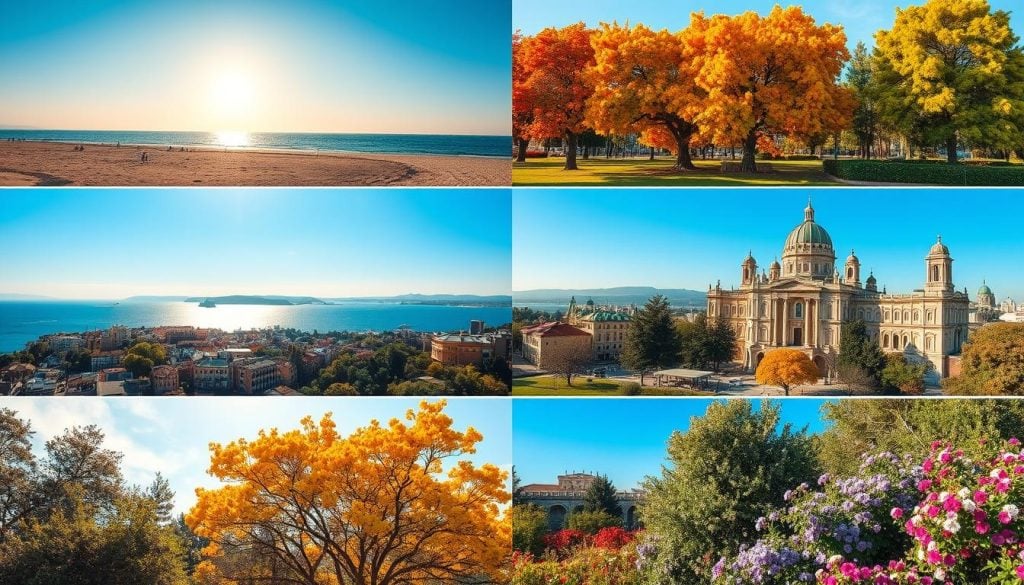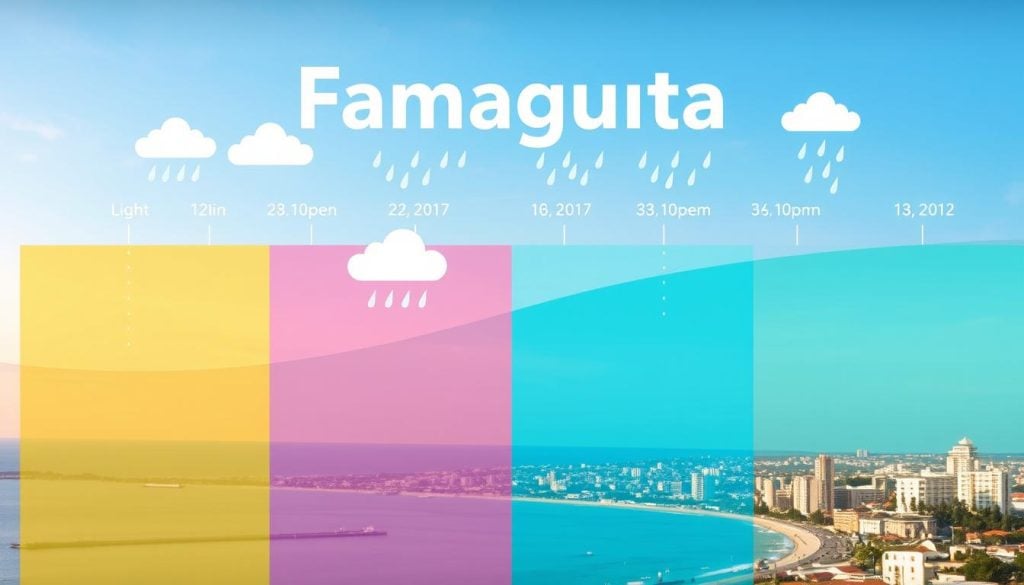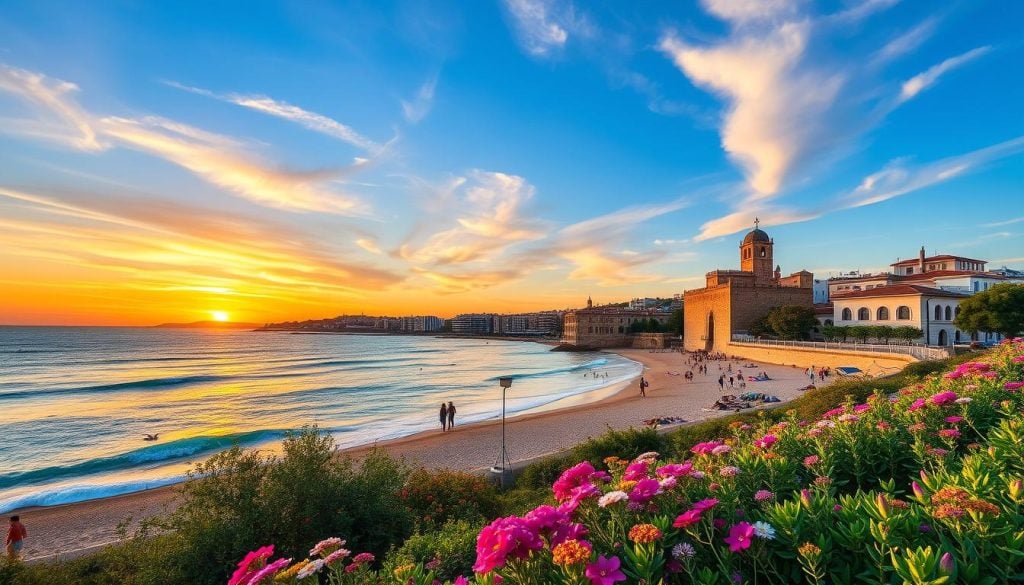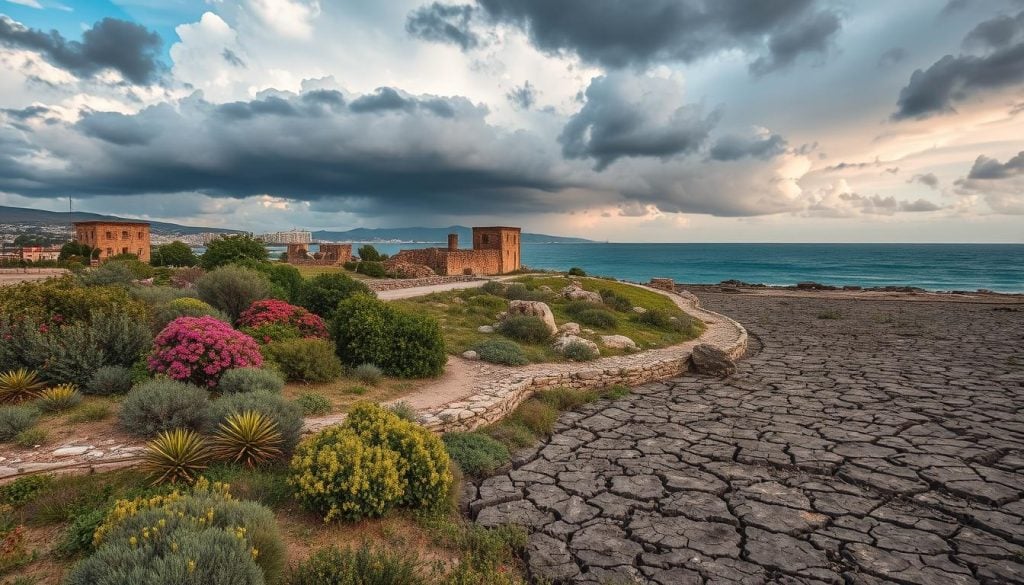Ever thought about how Famagusta’s weather might affect your travel plans? This guide will help you understand Famagusta’s Mediterranean climate. It’s key to knowing what to expect when you visit this beautiful city.
Knowing about Famagusta’s weather is crucial. It includes temperature, rain, and changes with the seasons. With this info, you can plan your trip to enjoy every moment in this amazing place.
Introduction to Famagusta Climate
Famagusta, in North Cyprus, has a unique Mediterranean climate. It’s known for its sunny and warm weather, attracting many visitors. The area has long, hot summers and mild winters, making it a great place to visit any time of the year.
With over 300 sunny days a year, Famagusta’s beauty shines through. Knowing the weather patterns helps you plan your trip. This way, you can make the most of your visit.
Summer, from June to September, is hot and dry. Winter is cooler but still mild. This mix of weather means you can enjoy outdoor activities and see sights all year.
Understanding Famagusta’s climate helps you plan better. It ensures you get the most out of this beautiful place.
What is the climate like in Famagusta?
Famagusta has long, hot summers and mild winters. This makes it a great place to visit all year. The city gets a lot of sunshine, which adds to its lively vibe and makes outdoor fun easy.
Overview of Climate Conditions
The climate in Famagusta is mostly Mediterranean. This means dry and warm summers and wet but mild winters. The average temperature is about 20°C (68°F), making it comfy for locals and visitors.
In the summer, temperatures can go over 30°C (86°F). This creates a warm but pleasant weather.
Sunshine and Temperature Trends
Famagusta gets a lot of sunshine, especially from June to September. During these months, the sun shines for up to 11 hours a day. This perfect weather is great for beach fun and visiting historical sites.
Even in winter, Famagusta still gets a lot of sunshine. On average, it gets about 5 hours of sun a day. This means you can still enjoy being outside.
Famagusta Weather Throughout the Year
Famagusta has a warm Mediterranean climate, making it great all year. Summers are hot, and winters are mild. Summer days can hit over 90°F, perfect for beaches and exploring.
Fall brings cooler temperatures, ideal for sightseeing. The average temperature is between 65°F and 80°F. Winter nights get chilly, but days are still warm, inviting visitors.
Spring is a beautiful time with flowers blooming and temperatures rising. It’s great for visiting historical sites, with temperatures in the 70°F range.
The following table outlines the average temperatures throughout the year:
| Month | Average Temperature (°F) |
|---|---|
| January | 50 |
| February | 53 |
| March | 60 |
| April | 68 |
| May | 75 |
| June | 83 |
| July | 88 |
| August | 90 |
| September | 82 |
| October | 73 |
| November | 62 |
| December | 53 |
Planning your visit based on these temperatures ensures a wonderful time in Famagusta, no matter the season.
Understanding Famagusta Temperature Variations
Famagusta’s temperature changes a lot throughout the year. Each season has its own average temperature. Knowing these changes helps you pack right and plan your activities.
Average Temperature in Famagusta
In summer, Famagusta gets very warm, with temperatures reaching 30-35°C (86-95°F). This makes it perfect for beach lovers. But, in winter, it cools down to 13-17°C (high 50s °F). This mild weather is great for outdoor fun all year.
Seasonal Temperature Fluctuations
Spring and fall in Famagusta are special. Temperatures then are between 18-25°C (64-77°F). This makes visiting very enjoyable. Knowing these changes helps you choose what to wear and plan your day.
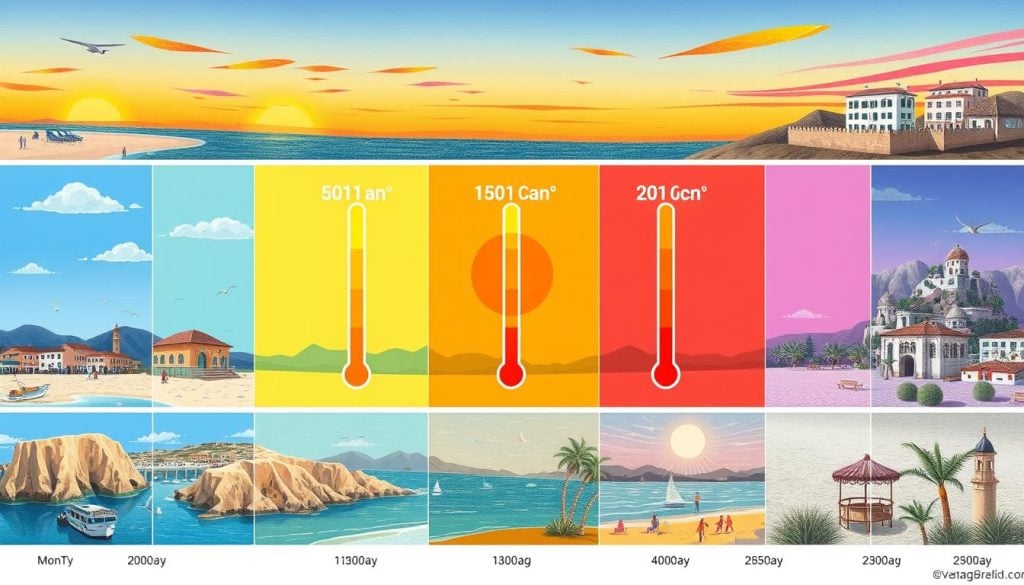
Famagusta Precipitation Patterns
Understanding Famagusta’s rainfall is key for planning your trip. The area sees different rain patterns all year, impacting outdoor fun and travel plans. Knowing when it rains helps you pack right and pick the best times to explore.
Monthly Breakdown of Rainfall
| Month | Average Precipitation (mm) | Average Rainy Days |
|---|---|---|
| January | 75 | 10 |
| February | 65 | 8 |
| March | 50 | 6 |
| April | 25 | 3 |
| May | 15 | 2 |
| June | 5 | 1 |
| July | 0 | 0 |
| August | 2 | 1 |
| September | 10 | 2 |
| October | 30 | 5 |
| November | 60 | 7 |
| December | 80 | 9 |
Rainy Days: What to Expect
Famagusta’s weather changes a lot during the rainy season, from November to March. Summer is usually dry, but fall and winter bring more rain. Travelers should be ready for rain, especially from late autumn to early spring.
Analyzing Famagusta Seasonal Weather
Famagusta has different weather seasons, making it fun all year round. Knowing about winter and summer can make your visit better. You’ll get to enjoy everything the town offers.
Winter Weather in Famagusta
Winters in Famagusta are mild, unlike many places. Temperatures range from 50°F to 65°F, perfect for exploring. Even though it rains sometimes, there are more sunny days. This makes winter great for outdoor fun.
Summer Weather: Coping with Heat
Summer in Famagusta is very hot. Daytime can hit over 85°F, sometimes reaching 100°F. It’s important to stay cool. Here are some tips for enjoying the outdoors:
- Drink lots of water to stay hydrated.
- Go out early or late to avoid the sun.
- Wear light, breathable clothes to keep cool.
- Find shade and use sunscreen to protect your skin.
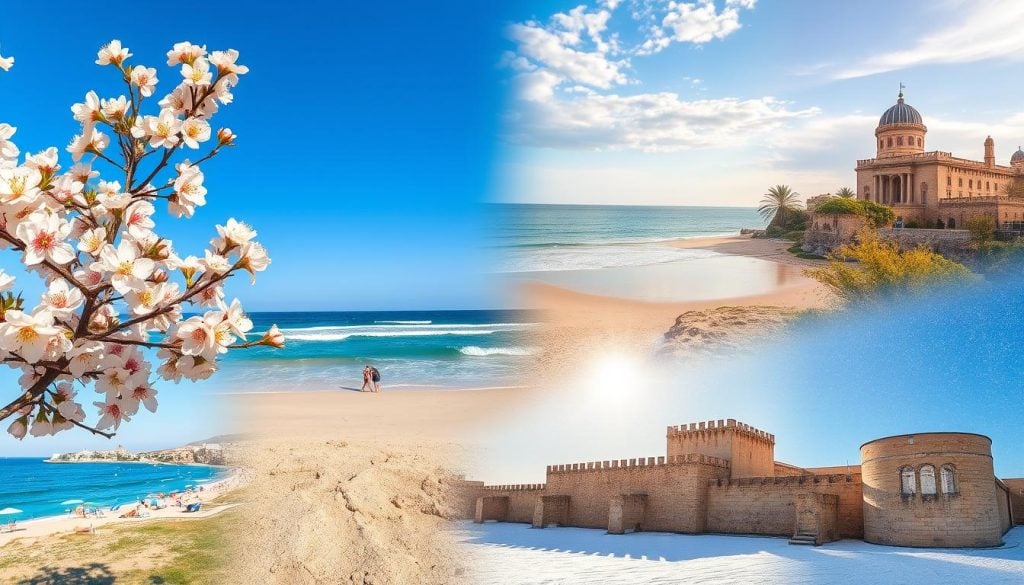
By understanding Famagusta’s weather, you can have a great trip. You’ll stay comfortable and enjoy everything the town has to offer.
The Best Time to Visit Famagusta
Planning your trip to Famagusta can make a big difference. This city has a Mediterranean climate, making some months better than others. May, June, September, and October are the best times to visit. They offer nice weather and not much rain.
During these months, you can really enjoy Famagusta’s seasonal weather. It’s perfect for exploring and outdoor fun.
Optimal Months for Travelers
Famagusta has its own charm in every season. Here are the best months to visit:
- May: Enjoy mild temperatures perfect for sightseeing.
- June: Experience warm weather, ideal for swimming.
- September: Pleasant temperatures provide a great time to explore historical sites.
- October: Enjoy comfortable weather with fewer crowds, perfect for a relaxing getaway.
Activities for Each Season
Every season in Famagusta offers something special. Here are some activities for each time of year:
| Season | Activities |
|---|---|
| Spring (March to May) | Hiking, cultural festivals, and outdoor dining. |
| Summer (June to August) | Beaching, water sports, and nightlife. |
| Fall (September to November) | Exploring historical ruins, wine tasting, and local markets. |
Understanding Famagusta Climate Conditions
The Famagusta climate is key to enjoying this beautiful city. It has hot, dry summers and mild, wet winters. Knowing the climate helps you make the most of your visit.
Famagusta’s weather changes a lot throughout the year. This is due to its location and winds. Summer can be hot, but breezes from the northeast help cool things down. Humidity also changes, with summer being more humid near the coast.
In winter, it’s cooler and rainier, making it great for outdoor fun. Planning your activities with the weather in mind makes your trip more enjoyable.
| Month | Average Temperature (°F) | Average Humidity (%) | Prevailing Wind Direction |
|---|---|---|---|
| January | 50 | 65 | Northeast |
| April | 64 | 60 | Northeast |
| July | 80 | 55 | Northeast |
| October | 70 | 65 | Calm |
Understanding Famagusta’s climate helps you plan a better trip. It ensures you have the best time in this historic place.
Famagusta Weather Patterns and Trends
The climate in Famagusta has changed a lot over time. These changes are part of global climate trends. Knowing how climate change affects Famagusta is key for both locals and visitors. It helps with planning trips and outdoor fun.
Climate Change Impact on Famagusta
Climate change has made Famagusta’s weather patterns a concern. We see hotter summers and more unpredictable seasons. Rising sea levels and changes in rain patterns threaten the area’s environment and buildings.
Historical Weather Trends
Looking back, Famagusta’s weather has shifted. Summers are hotter, and winters are more unpredictable. The way rain falls has also changed. Travelers need to know these changes to plan their trips well.
| Year | Average Summer Temperature (°C) | Average Winter Temperature (°C) | Annual Rainfall (mm) |
|---|---|---|---|
| 2010 | 33 | 10 | 500 |
| 2015 | 35 | 9 | 450 |
| 2020 | 36 | 8 | 400 |
| 2023 | 37 | 7 | 380 |
Understanding climate change in Famagusta and its weather history helps with planning. It makes sure your visit is enjoyable and memorable.
Tips for Coping with Famagusta’s Climate
Knowing about Famagusta’s weather is key for a great trip. Packing right means you’re set for any weather. Here are some tips to help you deal with Famagusta’s changing climate.
What to Pack for Your Trip
Make sure to include these must-haves in your bag:
- Lightweight clothing: Summers are hot, so choose breathable fabrics.
- Swimwear: Enjoy the beaches with the right swimwear.
- Sun protection: Don’t forget sunscreen, hats, and sunglasses for sun safety.
- Layers: Bring a light jacket or sweater for cooler nights and winter days.
Seasonal Clothing Recommendations
Adjusting your clothes for each season makes your trip better:
| Season | Recommended Clothing | Additional Items |
|---|---|---|
| Spring | Light layers, long sleeves | Umbrella, comfortable walking shoes |
| Summer | Shorts, T-shirts, sundresses | Hat, beach towel |
| Fall | Medium-weight layers, jeans | Light jacket, scarf |
| Winter | Warm layers, thermal clothing | Coat, gloves, sturdy footwear |
Outdoor Activities Based on Famagusta Weather
Famagusta is a great place for outdoor fun all year round. The weather changes the activities you can do, from beach days to exploring old sites. You can plan your trip based on the weather in Famagusta.
Beaches and Water Sports
In warm weather, Famagusta is perfect for beach lovers and water sports fans. The Mediterranean climate is ideal for spending time on the beautiful beaches. You can enjoy:
- Swimming
- Sailing
- Jet skiing
- Snorkeling
- Parasailing
Late spring and summer are the best times for these activities. The sea is warm, and the beaches are beautiful for a day of fun.
Exploring Historical Sites in Different Seasons
Famagusta is full of history and culture. You can see ancient ruins and landmarks. The cooler months are great for visiting these places without the summer heat.
- St. Nicholas Cathedral
- The Venetian City Walls
- Othello Castle
Visiting in autumn or spring is comfortable. You can take walking tours and enjoy the history without the crowds.
Conclusion
Knowing about Famagusta’s climate is key for a great trip. This place is famous for its history and stunning views. By learning about the weather, you can make your visit even better.
When planning your trip, think about the best months to go. Whether you love sunny beaches or exploring history, knowing the weather helps. It makes your visit more enjoyable.
Plan your trip with the weather in mind. This way, your trip to Famagusta will be amazing. You’ll have fun activities for any season. Your trip will be filled with wonderful memories.

































